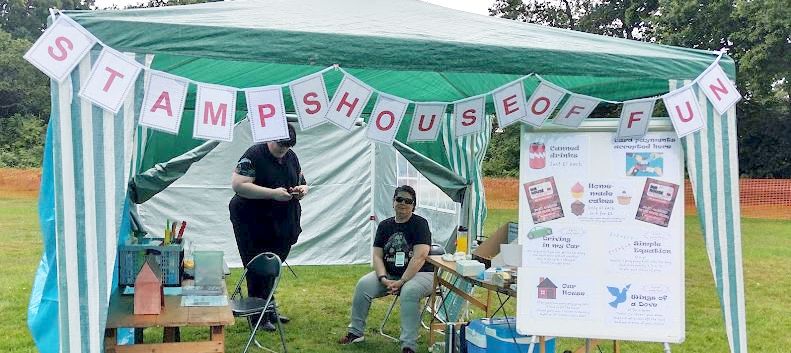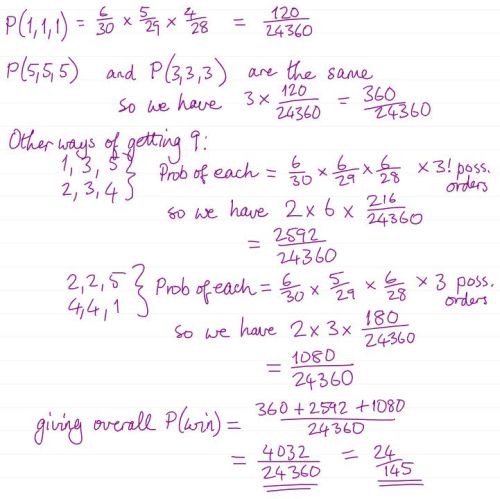Madness-themed fun carnival game for Maths practice
Something a little different this month, since it’s the summer holidays.
This year I’m running a stall at a couple of local carnival-type events to promote my theatre company (STAMPS)’s show and use some carnival games to fundraise while I’m at it. The show is “Our House”, a juke box musical built around Madness songs, and it’s on at the Core Theatre, Solihull, 31st October – 4th November 2023. Please come and see it if you’re local!

Take a look at this article on the costs of putting on a theatre show if you’re interested in knowing why we need to fundraise!
(Note: The show I’m actually performing in this autumn is Shrek the Musical, with a different company, because STAMPS’ allocated week in the theatre this year falls in half term and clashes with family commitments, but as Treasurer I’m still heavily involved with the society. Shrek has the same story as the film but with its own musical score. Please come and see that too if you can!)
The overall setup
The whole stall is themed around Madness songs. The stall itself is called “STAMPS House of Fun” (you can see the bunting in the image above) and each of our carnival games is themed to a different song that’s in the show. We’ve got:
- Wings of a Dove – tin can alley with bean bags shaped like birds
- Driving in My Car – a beat-the-buzzer game with a little car attached to the wand; you have to get the full length of the twisty wire “road” without crashing. (Incidentally this particular game makes a perfect crashing/tinkling noise when you do crash!)
- Our House – a little house made out of a cardboard box and filled with ping-pong balls. (You can just see its gable end on the left in the picture of the stall.) Players have to guess how many balls there are, with the closest guess winning tickets for the show
- Simple Equation – a lesser-known Madness song. The game is my own invention, and is what this blog post centres on.

The “Simple Equation” carnival game
The idea
We’ve all seen carnival games that involve throwing (or rolling) something to land on a target, whether that’s getting a ping-pong ball into a goldfish bowl, a football into a toilet (the stall next to us at Shirley Carnival had this one!), or a hoop to land over a prize. This is the same sort of idea, with a maths element inspired by the song title – and it was also a use for the spare ping-pong balls that I had left over after filling the “Our House” house!
I cadged an egg tray from a local butcher and painted the sections in five different colours, each corresponding to a score from 1 to 5. I happened to have a box that was just the right size to contain any balls that overshot the tray – I didn’t want to make it difficult to get any score at all, just not too easy to get the necessary score to win.
How it works and where the maths comes in
The player gets three balls and has to bounce each ball off the table in front of the box so that it lands in the tray. They win if they get a total score of 3, 9 or 15 using all three balls.

In the image above, there’s a blue (1 point), a green (2 points) and a yellow (3 points), giving a total of 6 points.
So there’s a bit more strategy involved than in your typical carnival game, and a little mental arithmetic. For example, if your first ball scores a 5 then you obviously can’t get a total of 3 but you can aim for either 9 or 15. If your second ball gets a 3 then you no longer have 15 in your sights but you could still get get a total of 9, and it’s simple to work out that you need to score 1 with your final ball.
I think it would be great for a primary school fair, but my teenage kids spent quite a while paying with it too!
Variations
There are quite a few ways you could vary this carnival game.
It could be used to practise a range of maths skills – for example the target might be given as “a multiple of 4” or “the difference between 20 and 13” or “the HCF of 24 and 32”.
You could have the player determine their own target total by rolling dice – though to get a range of possible targets for 3 to 15 you’d need three 5-sided dice. An alternative would be to set up the egg crate so that the scores per ball range from 1 to 6 instead of 1 to 5 as in my version, then you could use ordinary 6-sided dice.
You could use more (or fewer) balls and adjust the targets accordingly.
With very young children – or if you wanted to remove the maths element for other reasons – you could just set a target of getting all three balls in compartments of the same colour.
The player could stand behind a line maybe a metre away and just throw the balls from there – a useful option if you don’t have a bouncy surface in front of the crate.
Two or more players could compete to be the first to reach or exceed a set total score (a bit like a game of darts)
A probability challenge for more advanced students
A student who has studied probability at a fairly advanced level (GCSE Statistics or A-level Maths), could be set the challenge of working out the actual probability of a win (assuming that all compartments are equally likely to have the ball land in them, and all shots are random).
If you have an understanding of permutations and combinations then you might like to have a go!
I’ve worked it out for the original game with a target score of exactly 3, 9 or 15 – you can see the solution by clicking on the link below – but there are any number of variations!
Conclusion
This is an easy game to make and can be a useful tool for practising a range of arithmetic skills, as well as being fun!
Feel free to steal my idea and use it for your own ends!
If you’ve found this article helpful then please share it with anyone else who you think would benefit (use the social sharing buttons if you like). If you have any suggestions for improvement or other topics that you’d like to see covered, then please comment below or drop me a line using my contact form.
On my sister site at at mathscourses.co.uk you can find – among other things – a great-value suite of courses covering the entire GCSE (and Edexcel IGCSE) Foundation content, and the “Flying Start to A-level Maths” course for those who want to get top grades at GCSE and hit the ground running at A-level – please take a look!
If you’d like to be kept up to date with my new content then please sign up to my mailing list using the form at the bottom of this page, which will also give you access to my collection of free downloads.
Solution to probability challenge:
The probability of a win is 24/145 in its simplest form.
Here’s the working:

